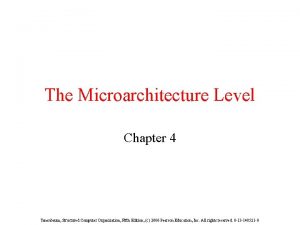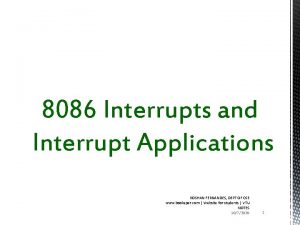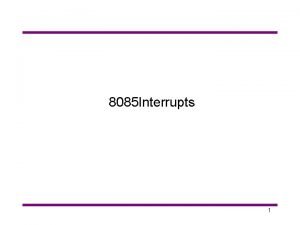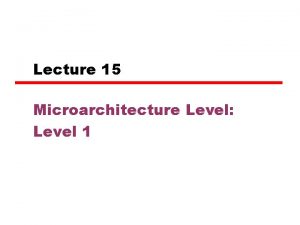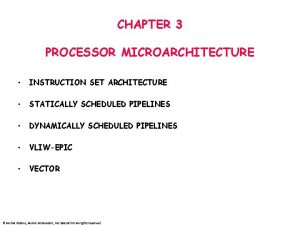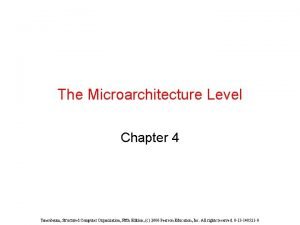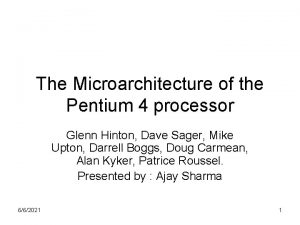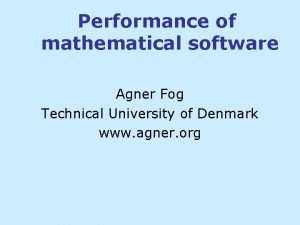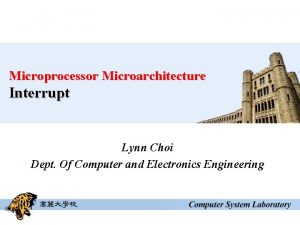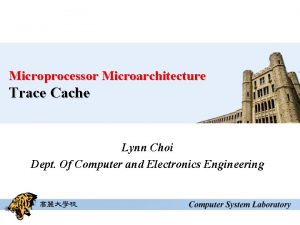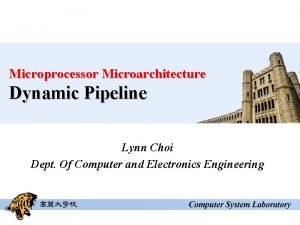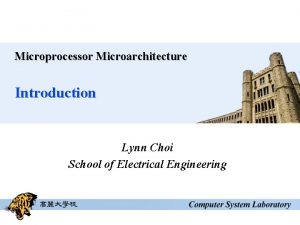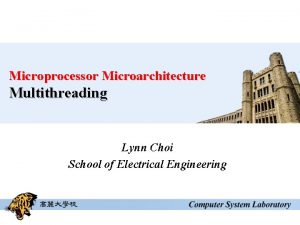Microprocessor Microarchitecture Interrupt Lynn Choi Dept Of Computer










- Slides: 10

Microprocessor Microarchitecture Interrupt Lynn Choi Dept. Of Computer and Electronics Engineering

Interrupts q Interrupts Forced transfer of control to a procedure (handler) due to external events (interrupts) or due to an erroneous condition (exceptions) Exception - Generated by the currently running process due to an erroneous condition - Synchronous, internal Interrupt - Asynchronous, external events q Interrupt handling mechanism Allows interrupts/exceptions to be handled transparently to the executing process (application programs and operating system) Procedure - When an interrupt is received or an exception condition detection, the current task is suspended and transfer automatically goes to a handler - After the handler is complete, the interrupted task resumes without loss of continuity, unless recovery is not possible or the interrupt causes the currently running task to be terminated.

Exceptions q Exception Classification (processor-generated) Fault - Return to the faulting instruction - Reported during the execution of the faulting instruction - Virtual memory faults 6 TLB miss, page fault, protection - Illegal operations 6 divide by zero, invalid opcode, misaligned reference Trap - Return to the next instruction (after the trapping instruction) 6 For a JMP instruction, the next instruction should point to the target of the JMP instruction - Reported immediately following the execution of the trapping instruction - Examples: breakpoint, debug

Exceptions Abort - Suspend the process at an unpredictable location Does not report the precise location of the instruction causing the exception 6 Does not allow restart of the program 6 - Severe errors or malfunctions - Abort handlers are designed to collect diagnostic information about the processor’s state and then perform a graceful system shutdown - Examples: bit error (parity error), inconsistent or illegal values in system tables q Software-generated exception INT n instruction generates an exception with an exception number (n) as an operand

Precise Exception All exceptions except aborts must report the exception on a precise instruction boundary q Precise exception model q All integer/FP exceptions are reported on the faulting instruction All previous instructions are completed before the interruption point All subsequent operations are nullified After handling the exception, the execution resumes at the faulting instruction (fault) or at the next instruction (trap) For O-O-O processors, - Interrupts are taken at the retirement phase of instruction execution; so they are always taken in-order.

Exception Handling q Exception (interrupt) vector Each exception or an interrupt is associated with an identification number, vector q Exception procedure Flush all the instructions fetched subsequent to the instruction causing the exception condition from the pipeline Drain the pipeline: complete all previous instructions - Complete all outstanding write operations prior to the faulting instruction Save the PC of the next instruction to execute Also need to save the necessary registers and stack pointers to allow it to restore itself to its state Vector the interrupt Fetch instruction from the ISR and service the interrupt Return from the interrupt

(External) Interrupt q Interrupt Asynchronous Caused by external events, IO devices Return to the next instruction for a restart q Interrupt Classification Maskable interrupt - Can be disabled/enabled by an instruction - Generated by asserting INTR pin or sending interrupt messages over the APIC (Advanced Programmable Interrupt Controller) bus - External interrupt controllers 6 Intel 8259 PIC (programmable interrupt controller) delivers the interrupt vectors on the system bus during interrupt acknowledge cycle

Interrupt Non-maskable interrupt (NMI) - Cannot be disabled by program - Received on the processor’s NMI# input pin Software interrupt - Generated by INT n instruction 6 INT instruction can be used to generate an interrupt or an exception by using a vector number as an operand - Viewed as an implicit call to interrupt handler of interrupt vector n - No mechanism for masking interrupts

Interrupt Priority q Predefined order of different interrupts H/W Reset, Machine Check Abort External HW interventions - INIT - like H/W reset without flushing caches) - SMI (System (e. g. power) Management Interrupt) Traps on the previous instruction External Interrupts - NMI, MI Faults on executing an instruction - DTLB faults - FP exception, overflow, alignment Faults from fetching/decoding an instruction - ITLB faults: page miss, access/protection violation - Illegal opcode q Lower priority exceptions are regenerated after returning from the higher priority interrupt handler

Interrupt Priority Parallel (Centralized) Arbitration (can use Priority Encoder) BR BG M M Bus Request Bus Grant Serial Arbitration (Daisy Chaining, M 0 has the highest priority) BG BGi BGo M 0 BR A. U. BR Polling (by S/W) A. U. BR A BGi BGo M 1 BR BGi BGo M 2 BR M M M BR A From UCB Patterson
